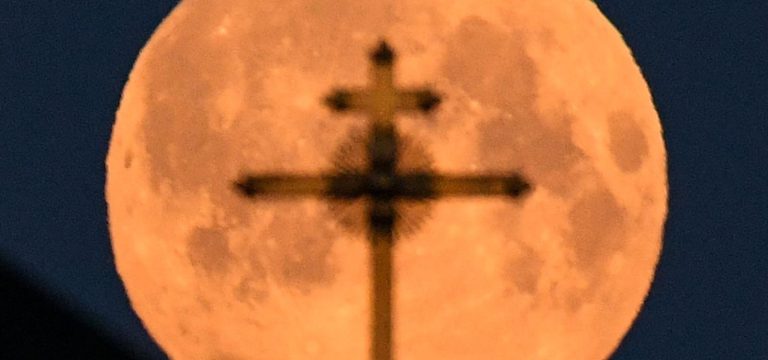This photo taken on April 8, 2020 shows the closest supermoon to Earth, also known as … (+)
The phases of the moon determine the date of Easter. Western Easter is the first Sunday after the first full moon after the equinox, while Eastern Easter is after Passover.
This year, Easter – a Christian celebration of Jesus Christ rising from the dead – will take place on Sunday, March 31 for Western Christians and Sunday, May 5 for Eastern Orthodox Christians.
The reason why the dates of Easter change every year – and why they differ so much between Western and Eastern Christianity – is primarily a matter of astronomy and, more specifically, the phases of the moon.
Easter is a lunar festival
While some religions use a predominantly lunar calendar, this is not the case with Christianity, and yet Easter is a lunar festival, just like Ramadan, Passover and the Chinese Lunar New Year.
At the heart of it all is the lunar year. While the Earth takes 365.25 days to orbit the Sun, the Moon takes 29.5 days to orbit the Earth. Thus, a lunar year has 354.3 days. There is a gap of 10 or 11 days between the two, which explains why the dates of Easter differ so much from one year to the next.
How the date of Western Easter is decided
Western Christians celebrate Easter on the first Sunday after the first full moon occurring on or after the spring equinox, as determined by the Gregorian calendar.
- This year, the vernal equinox, or vernal equinox, occurs on Wednesday, March 20.
- The first full moon that follows is the “Worm Moon” on Monday March 25, which is thus called the “Paschal Moon”.
- The following Sunday is March 31.
Easter is early because the full moon occurs just a few days after the spring equinox, which is more or less a fixed date (occurring between March 20 and 22 each year).
How the date of Eastern Easter is decided
Easter is celebrated by Eastern Christians on the first Sunday after Sunday after the first full moon after the Jewish holiday of Passover (Pesach). Passover celebrates the biblical story of the Israelites’ escape from slavery in Egypt.
Passover always begins on the 15th day of the Hebrew month of Nisan. Since the Hebrew calendar is largely based on the moon, Passover is celebrated in 2024 on Monday, April 22. It is the date of the fourth full moon of the year, the “Pink Moon”.
The Sunday after Passover is Sunday, May 5.
Why the two Easters are often the same date
Suppose a full moon occurs just before the date of the spring equinox. In this case, the “Paschal Moon” of Western Christianity will not occur until mid-April, thus delaying Easter Sunday and making it the same as the Easter date of Eastern Orthodox Christianity. This last happened in 2017 and will happen again in 2025.
I wish you clear skies and wide eyes.


